The Effects of Plastic Mulching Combined with Different Fertilizer Applications on Greenhouse Gas Emissions and Intensity, and Apple Yield in Northwestern China
Abstract
1. Introduction
2. Materials and Methods
2.1. Experimental Area
2.2. Experimental Design
2.3. Collection and Calculation of Samples
2.3.1. Collection of Gas Samples
2.3.2. Soil Sample Collection Process
2.4. Data Analysis and Evaluation
3. Results
3.1. Apple Yield
3.2. Ammonium Nitrogen and Nitrate Nitrogen Dynamics and Greenhouse Gases in Apple Orchards
3.2.1. Ammonium Nitrogen and Nitrate Nitrogen Dynamics in Apple Orchards
3.2.2. Greenhouse Gas Emissions in the Apple Orchard (N2O, CO2, and CH4)
3.3. Global Warming Potential (GWP) and Green House Gas Intensity (GHGI)
3.4. The Influence of Environmental Factors on GHG Emissions in Soil
4. Discussion
4.1. The Effects of PM and NM Combined with Different Fertilizer Applications on Nitrous Oxide Emissions
4.2. The Effects of PM and NM Combined with Different Fertilizer Applications on Carbon Dioxide Emissions
4.3. The Effects of PM and NM Combined with Different Fertilizer Applications on Methane Uptake
4.4. The Effects of Plastic Mulching Combined with the Different Fertilizer Applications on Apple Yield, N2O EFd, GWP, and GHGI
5. Conclusions
Supplementary Materials
Author Contributions
Funding
Institutional Review Board Statement
Informed Consent Statement
Data Availability Statement
Conflicts of Interest
References
- Chen, X.; Cui, Z.; Fan, M.; Vitousek, P.; Zhao, M.; Ma, W.; Wang, Z.; Zhang, W.; Yan, X.; Yang, J. Producing more grain with lower environmental costs. Nature 2014, 514, 486–489. [Google Scholar] [CrossRef] [PubMed]
- Dencső, M.; Horel, Á.; Bogunovic, I.; Tóth, E. Effects of environmental drivers and agricultural management on soil CO2 and N2O emissions. Agronomy 2020, 11, 54. [Google Scholar] [CrossRef]
- Townsend, J.; Moola, F.; Craig, M. Indigenous Peoples are critical to the success of nature-based solutions to climate change. Facets 2020, 5, 551–556. [Google Scholar] [CrossRef]
- Tubiello, F.N.; Salvatore, M.; Cóndor Golec, R.D.; Ferrara, A.; Rossi, S.; Biancalani, R.; Federici, S.; Jacobs, H.; Flammini, A. Agriculture, Forestry and Other Land Use Emissions by Sources and Removals by Sinks; FAO: Rome, Italy, 2014. [Google Scholar] [CrossRef]
- Yuan, J.; Xiang, J.; Liu, D.; Kang, H.; He, T.; Kim, S.; Lin, Y.; Freeman, C.; Ding, W. Rapid growth in greenhouse gas emissions from the adoption of industrial-scale aquaculture. Nat. Clim. Chang. 2019, 9, 318–322. [Google Scholar] [CrossRef]
- Sun, D.; Li, H.; Wang, E.; He, W.; Hao, W.; Yan, C.; Li, Y.; Mei, X.; Zhang, Y.; Sun, Z. An overview of the use of plastic-film mulching in China to increase crop yield and water-use efficiency. Natl. Sci. Rev. 2020, 7, 1523–1526. [Google Scholar] [CrossRef]
- Steinmetz, Z.; Wollmann, C.; Schaefer, M.; Buchmann, C.; David, J.; Tröger, J.; Muñoz, K.; Frör, O.; Schaumann, G.E. Plastic mulching in agriculture. Trading short-term agronomic benefits for long-term soil degradation? Sci. Total Environ. 2016, 550, 690–705. [Google Scholar] [CrossRef]
- Yao, Z.; Zheng, X.; Liu, C.; Lin, S.; Zuo, Q.; Butterbach-Bahl, K. Improving rice production sustainability by reducing water demand and greenhouse gas emissions with biodegradable films. Sci. Rep. 2017, 7, 39855. [Google Scholar] [CrossRef]
- Gao, H.; Yan, C.; Liu, Q.; Ding, W.; Chen, B.; Li, Z. Effects of plastic mulching and plastic residue on agricultural production: A meta-analysis. Sci. Total Environ. 2019, 651, 484–492. [Google Scholar] [CrossRef]
- Guo, C.; Liu, X. Effect of soil mulching on agricultural greenhouse gas emissions in China: A meta-analysis. PLoS ONE 2022, 17, e0262120. [Google Scholar] [CrossRef]
- Lisson, S.; Tarbath, M.; Corkrey, R.; Pinkard, E.; Laycock, B.; Howden, S.; Acuña, T.B.; Makin, A. Ambient climate and soil effects on the headspace under clear mulch film. Agric. Syst. 2016, 142, 41–50. [Google Scholar] [CrossRef]
- Han, J.; Zhang, A.; Kang, Y.; Han, J.; Yang, B.; Hussain, Q.; Wang, X.; Zhang, M.; Khan, M.A. Biochar promotes soil organic carbon sequestration and reduces net global warming potential in apple orchard: A two-year study in the Loess Plateau of China. Sci. Total Environ. 2022, 803, 150035. [Google Scholar] [CrossRef] [PubMed]
- Canton, H. Food and agriculture organization of the United Nations—FAO. In The Europa Directory of International Organizations 2021; Routledge: London, UK, 2021; pp. 297–305. [Google Scholar]
- Zhang, B.; Hu, Y.; Hill, R.L.; Wu, S.; Song, X. Combined effects of biomaterial amendments and rainwater harvesting on soil moisture, structure and apple roots in a rainfed apple orchard on the Loess Plateau, China. Agric. Water Manag. 2021, 248, 106776. [Google Scholar] [CrossRef]
- Zheng, J.; Fan, J.; Zhang, F.; Zhuang, Q. Evapotranspiration partitioning and water productivity of rainfed maize under contrasting mulching conditions in Northwest China. Agric. Water Manag. 2021, 243, 106473. [Google Scholar] [CrossRef]
- Qin, W.; Hu, C.; Oenema, O. Soil mulching significantly enhances yields and water and nitrogen use efficiencies of maize and wheat: A meta-analysis. Sci. Rep. 2015, 5, 16210. [Google Scholar] [CrossRef] [PubMed]
- Lee, J.; Chae, H.; Cho, S.; Song, H.; Kim, P.; Jeong, S. Impact of plastic film mulching on global warming in entire chemical and organic cropping systems: Life cycle assessment. J. Clean. Prod. 2021, 308, 127256. [Google Scholar] [CrossRef]
- Fang, H.; Li, Y.; Gu, X.; Yu, M.; Chen, P.; Li, Y.; Liu, F. Optimizing the impact of film mulching pattern and nitrogen application rate on maize production, gaseous N emissions, and utilization of water and nitrogen in northwest China. Agric. Water Manag. 2022, 261, 107350. [Google Scholar] [CrossRef]
- Liao, Y.; Cao, H.; Liu, X.; Li, H.; Hu, Q.; Xue, W. By increasing infiltration and reducing evaporation, mulching can improve the soil water environment and apple yield of orchards in semiarid areas. Agric. Water Manag. 2021, 253, 106936. [Google Scholar] [CrossRef]
- Lee, J.G.; Cho, S.R.; Jeong, S.T.; Hwang, H.Y.; Kim, P.J. Different response of plastic film mulching on greenhouse gas intensity (GHGI) between chemical and organic fertilization in maize upland soil. Sci. Total Environ. 2019, 696, 133827. [Google Scholar] [CrossRef]
- Liu, J.; Chen, X.; Zhan, A.; Luo, S.; Chen, H.; Jiang, H.; Huang, X.; Li, S. Methane uptake in semiarid farmland subjected to different mulching and nitrogen fertilization regimes. Biol. Fertil. Soils 2016, 52, 941–950. [Google Scholar] [CrossRef]
- Li, Y.; Feng, H.; Wu, W.; Jiang, Y.; Sun, J.; Zhang, Y.; Cheng, H.; Li, C.; Siddique, K.H.; Chen, J. Decreased greenhouse gas intensity of winter wheat production under plastic film mulching in semi-arid areas. Agric. Water Manag. 2022, 274, 107941. [Google Scholar] [CrossRef]
- Guo, Y.; Yin, W.; Chai, Q.; Fan, Z.; Hu, F.; Fan, H.; Zhao, C.; Yu, A.; Coulter, J.A. No tillage with previous plastic covering increases water harvesting and decreases soil CO2 emissions of wheat in dry regions. Soil Tillage Res. 2021, 208, 104883. [Google Scholar] [CrossRef]
- Wang, W.; Han, L.; Zhang, X.; Wei, K. Plastic film mulching affects N2O emission and ammonia oxidizers in drip irrigated potato soil in northwest China. Sci. Total Environ. 2021, 754, 142113. [Google Scholar] [CrossRef]
- Hou, L.; Liu, Z.; Zhao, J.; Ma, P.; Xu, X. Comprehensive assessment of fertilization, spatial variability of soil chemical properties, and relationships among nutrients, apple yield and orchard age: A case study in Luochuan County, China. Ecol. Indic. 2021, 122, 107285. [Google Scholar] [CrossRef]
- Pörtner, H.; Roberts, D.; Adams, H.; Adler, C.; Aldunce, P.; Ali, E.; Begum, R.A.; Betts, R.; Kerr, R.B.; Biesbroek, R. Climate Change 2022: Impacts, Adaptation and Vulnerability; IPCC: Geneva, Switzerland, 2022. [Google Scholar]
- Lv, F.; Song, J.; Giltrap, D.; Feng, Y.; Yang, X.; Zhang, S. Crop yield and N2O emission affected by long-term organic manure substitution fertilizer under winter wheat-summer maize cropping system. Sci. Total Environ. 2020, 732, 139321. [Google Scholar] [CrossRef] [PubMed]
- Zhang, B.; Su, S.; Duan, C.; Feng, H.; Chau, H.W.; He, J.; Li, Y.; Hill, R.L.; Wu, S.; Zou, Y. Effects of partial organic fertilizer replacement combined with rainwater collection system on soil water, nitrate-nitrogen and apple yield of rainfed apple orchard in the Loess Plateau of China: A 3-year field experiment. Agric. Water Manag. 2022, 260, 107295. [Google Scholar] [CrossRef]
- Huang, R.; Wang, Y.; Gao, X.; Liu, J.; Wang, Z.; Gao, M. Nitrous oxide emission and the related denitrifier community: A short-term response to organic manure substituting chemical fertilizer. Ecotoxicol. Environ. Saf. 2020, 192, 110291. [Google Scholar] [CrossRef] [PubMed]
- Zhang, Y.; Nie, Y.; Liu, Y.; Huang, X.; Yang, Y.; Xiong, H.; Zhu, H.; Li, Y. Characteristics of Greenhouse Gas Emissions from Yellow Paddy Soils under Long-Term Organic Fertilizer Application. Sustainability 2022, 14, 12574. [Google Scholar] [CrossRef]
- Xiang, W.; Wang, L.; Liu, T.; Li, S.; Zhao, Z.; Li, C. Effects of biochar plus inorganic nitrogen on the greenhouse gas and nitrogen use efficiency from rice fields. Sci. Agric. Sin. 2021, 53, 4634–4645. [Google Scholar]
- Xie, L.; Li, L.; Xie, J.; Wang, J.; Anwar, S.; Du, C.; Zhou, Y. Substituting inorganic fertilizers with organic amendment reduced nitrous oxide emissions by affecting nitrifiers’ microbial community. Land 2022, 11, 1702. [Google Scholar] [CrossRef]
- Wei, Z.; Ying, H.; Guo, X.; Zhuang, M.; Cui, Z.; Zhang, F. Substitution of mineral fertilizer with organic fertilizer in maize systems: A meta-analysis of reduced nitrogen and carbon emissions. Agronomy 2020, 10, 1149. [Google Scholar] [CrossRef]
- Githongo, M.W.; Musafiri, C.M.; Macharia, J.M.; Kiboi, M.N.; Fliessbach, A.; Muriuki, A.; Ngetich, F.K. Greenhouse gas fluxes from selected soil fertility management practices in humic nitisols of upper Eastern Kenya. Sustainability 2022, 14, 1938. [Google Scholar] [CrossRef]
- Xie, Y.; Zhang, J.; Jiang, H.; Yang, J.; Deng, S.; Li, X.; Guo, J.; Li, L.; Liu, X.; Zhou, G. Effects of different fertilization practices on greenhouse gas emissions from paddy soil. J. Agro-Environ. Sci. 2015, 3, 578–584. [Google Scholar]
- Hou, A.; Wang, Z.; Chen, G.; Patrick, W. Effects of organic and N fertilizers on methane production potential in a Chinese rice soil and its microbiological aspect. Nutr. Cycl. Agroecosyst. 2000, 58, 333–338. [Google Scholar] [CrossRef]
- Pandey, A.; Dou, F.; Morgan, C.L.; Guo, J.; Deng, J.; Schwab, P. Modeling organically fertilized flooded rice systems and its long-term effects on grain yield and methane emissions. Sci. Total Environ. 2021, 755, 142578. [Google Scholar] [CrossRef] [PubMed]
- Fan, Y.; Hao, X.; Carswell, A.; Misselbrook, T.; Ding, R.; Li, S.; Kang, S. Inorganic nitrogen fertilizer and high N application rate promote N2O emission and suppress CH4 uptake in a rotational vegetable system. Soil Tillage Res. 2021, 206, 104848. [Google Scholar] [CrossRef]
- Brenzinger, K.; Drost, S.M.; Korthals, G.; Bodelier, P.L. Organic residue amendments to modulate greenhouse gas emissions from agricultural soils. Front. Microbiol. 2018, 9, 3035. [Google Scholar] [CrossRef] [PubMed]
- Fentabil, M.M.; Nichol, C.F.; Jones, M.D.; Neilsen, G.H.; Neilsen, D.; Hannam, K.D. Effect of drip irrigation frequency, nitrogen rate and mulching on nitrous oxide emissions in a semi-arid climate: An assessment across two years in an apple orchard. Agric. Ecosyst. Environ. 2016, 235, 242–252. [Google Scholar] [CrossRef]
- Zhao, M.; Jiang, C.; Li, X.; He, X.; Hao, Q. Variations in nitrous oxide emissions as manipulated by plastic film mulching and fertilization over three successive years in a hot pepper-radish rotated vegetable production system. Agric. Ecosyst. Environ. 2020, 304, 107127. [Google Scholar] [CrossRef]
- Mehmood, F.; Wang, G.; Gao, Y.; Liang, Y.; Zain, M.; Rahman, S.U.; Duan, A. Impacts of irrigation managements on soil CO2 emission and soil CH4 uptake of winter wheat field in the North China plain. Water 2021, 13, 2052. [Google Scholar] [CrossRef]
- Liu, D.; Sun, H.; Liao, X.; Luo, J.; Lindsey, S.; Yuan, J.; He, T.; Zaman, M.; Ding, W. N2O and NO emissions as affected by the continuous combined application of organic and mineral N fertilizer to a soil on the North China Plain. Agronomy 2020, 10, 1965. [Google Scholar] [CrossRef]
- Xu, P.; Han, Z.; Wu, J.; Li, Z.; Wang, J.; Zou, J. Emissions of greenhouse gases and NO from rice fields and a peach orchard as affected by N input and land-use conversion. Agronomy 2022, 12, 1850. [Google Scholar] [CrossRef]
- Toma, Y.; Higuchi, T.; Nagata, O.; Kato, Y.; Izumiya, T.; Oomori, S.; Ueno, H. Efflux of soil nitrous oxide from applied fertilizer containing organic materials in Citrus unshiu field in Southwestern Japan. Agriculture 2017, 7, 10. [Google Scholar] [CrossRef]
- Weijie, L.; Li, W. Effects of a cover crop on deep soil water and root characteristics in a dryland apple orchard on the Loess Plateau. Acta Prataculturae Sin. 2023, 32, 63. [Google Scholar]
- Sparks, D.L.; Page, A.L.; Helmke, P.A.; Loeppert, R.H. Methods of Soil Analysis, Part 3: Chemical Methods; John Wiley & Sons: Hoboken, NJ, USA, 2020; Volume 14. [Google Scholar]
- Li, Z. Progresses in the research on major greenhouse gas emissions in the northern dry farmland. Liaoning Agric. Sci. 2020, 2, 52–56. [Google Scholar]
- Yang, X.; Hou, H.; Xu, Y.; Raza, S.T.; Wang, L.; Wei, W.; Wu, J.; Chen, Z. Divergent pattern of soil CO2, CH4 and N2O emissions in 18-year citrus orchard and Camellia oleifera plantations converted from natural shrub forests. Appl. Soil Ecol. 2022, 175, 104447. [Google Scholar] [CrossRef]
- Wu, X.; Chen, Z.; Kiese, R.; Fu, J.; Gschwendter, S.; Schloter, M.; Liu, C.; Butterbach-Bahl, K.; Wolf, B.; Dannenmann, M. Dinitrogen (N 2) pulse emissions during freeze-thaw cycles from montane grassland soil. Biol. Fertil. Soils 2020, 56, 959–972. [Google Scholar] [CrossRef]
- Yu, Y.; Zhang, Y.; Xiao, M.; Zhao, C.; Yao, H. A meta-analysis of film mulching cultivation effects on soil organic carbon and soil greenhouse gas fluxes. Catena 2021, 206, 105483. [Google Scholar] [CrossRef]
- Abubakar, S.A.; Hamani, A.K.M.; Chen, J.; Sun, W.; Wang, G.; Gao, Y.; Duan, A. Optimizing N-fertigation scheduling maintains yield and mitigates global warming potential of winter wheat field in North China Plain. J. Clean. Prod. 2022, 357, 131906. [Google Scholar] [CrossRef]
- Berger, S.; Kim, Y.; Kettering, J.; Gebauer, G. Plastic mulching in agriculture—Friend or foe of N2O emissions? Agric. Ecosyst. Environ. 2013, 167, 43–51. [Google Scholar] [CrossRef]
- Akhtar, K.; Wang, W.; Ren, G.; Khan, A.; Enguang, N.; Khan, A.; Feng, Y.; Yang, G.; Wang, H. Straw mulching with inorganic nitrogen fertilizer reduces soil CO2 and N2O emissions and improves wheat yield. Sci Total Environ. 2020, 741, 140488. [Google Scholar] [CrossRef]
- Wu, H.; MacDonald, G.K.; Galloway, J.N.; Zhang, L.; Gao, L.; Yang, L.; Yang, J.; Li, X.; Li, H.; Yang, T. The influence of crop and chemical fertilizer combinations on greenhouse gas emissions: A partial life-cycle assessment of fertilizer production and use in China. Resour. Conserv. Recycl. 2021, 168, 105303. [Google Scholar] [CrossRef]
- Li, Y.; Zheng, Q.; Yang, R.; Zhuang, S.; Lin, W.; Li, Y. Evaluating microbial role in reducing N2O emission by dual isotopocule mapping following substitution of inorganic fertilizer for organic fertilizer. J. Clean. Prod. 2021, 326, 129442. [Google Scholar] [CrossRef]
- Das, S.; Adhya, T.K. Effect of combine application of organic manure and inorganic fertilizer on methane and nitrous oxide emissions from a tropical flooded soil planted to rice. Geoderma 2014, 213, 185–192. [Google Scholar] [CrossRef]
- Yang, Y.; Liu, H.; Lv, J. Response of N2O emission and denitrification genes to different inorganic and organic amendments. Sci. Rep. 2022, 12, 3940. [Google Scholar] [CrossRef] [PubMed]
- Zhou, B.; Wang, Y.; Feng, Y.; Lin, X. The application of rapidly composted manure decreases paddy CH4 emission by adversely influencing methanogenic archaeal community: A greenhouse study. J. Soils Sediments 2016, 16, 1889–1900. [Google Scholar] [CrossRef]
- Mukumbuta, I.; Shimizu, M.; Hatano, R. Mitigating global warming potential and greenhouse gas intensities by applying composted manure in cornfield: A 3-year field study in an andosol soil. Agriculture 2017, 7, 13. [Google Scholar] [CrossRef]
- Zhang, D.; Hu, X.; Ma, J.; Guo, Y.; Zong, J.; Yang, X. Effects of tillage and fertility on soil nitrogen balance and greenhouse gas emissions of wheat-maize rotation system in Central Henan Province, China. J. Appl. Ecol. 2021, 32, 1753–1760. [Google Scholar]
- Li, Y.; Wen, Y.; Lin, Z.; Zhao, B. Effect of different manures combined with chemical fertilizer on yields of crops and gaseous N loss in farmland. J. Plant Nutr. Fertil 2019, 25, 1835–1846. [Google Scholar]
- Wallman, M.; Lammirato, C.; Delin, S.; Klemedtsson, L.; Weslien, P.; Rütting, T. Nitrous oxide emissions from five fertilizer treatments during one year–High-frequency measurements on a Swedish Cambisol. Agric. Ecosyst. Environ. 2022, 337, 108062. [Google Scholar] [CrossRef]
- Yuying, W.; Xiaoxin, L.; Wenxu, D.; Yuming, Z.; Shuping, Q.; Chunsheng, H. Review on greenhouse gas emission and reduction in wheat-maize double cropping system in the North China Plain. Chin. J. Eco-Agric. 2018, 26, 167–174. [Google Scholar]
- Zheng, M.; Liu, J.; Jiang, P.; Wu, J.; Li, Y.; Li, S. Effects of nitrogen fertilizer management on CH4 and N2O emissions in paddy field. Environ. Sci. 2022, 43, 2171–2181. [Google Scholar]
- Guangbin, Z.; Kaifu, S.; Xi, M.; Qiong, H.; Jing, M.; Hua, G.; Yao, Z.; Keith, P.; Xiaoyuan, Y.; Hua, X. Nitrous oxide emissions, ammonia volatilization, and grain-heavy metal levels during the wheat season: Effect of partial organic substitution for chemical fertilizer. Agric. Ecosyst. Environ. 2021, 311, 107340. [Google Scholar] [CrossRef]
- Pang, J.; Wang, X.; Peng, C.; Mu, Y.; Ouyang, Z.; Lu, F.; Zhang, H.; Zhang, S.; Liu, W. Nitrous oxide emissions from soils under traditional cropland and apple orchard in the semi-arid Loess Plateau of China. Agric. Ecosyst. Environ. 2019, 269, 116–124. [Google Scholar] [CrossRef]
- Xie, B.; Gu, J.; Yu, J.; Han, G.; Zheng, X.; Xu, Y.; Lin, H. Effects of n fertilizer application on soil N2O emissions and CH4 uptake: A two-year study in an apple orchard in Eastern China. Atmosphere 2017, 8, 181. [Google Scholar] [CrossRef]
- Zhong, Y.; Li, J.; Xiong, H. Effect of deficit irrigation on soil CO2 and N2O emissions and winter wheat yield. J. Clean. Prod. 2021, 279, 123718. [Google Scholar] [CrossRef]
- Nan, W.; Yue, S.; Huang, H.; Li, S.; Shen, Y. Effects of plastic film mulching on soil greenhouse gases (CO2, CH4 and N2O) concentration within soil profiles in maize fields on the Loess Plateau, China. J. Integr. Agric. 2016, 15, 451–464. [Google Scholar] [CrossRef]
- Li, Y.; Xie, H.; Ren, Z.; Ding, Y.; Long, M.; Zhang, G.; Qin, X.; Siddique, K.H.; Liao, Y. Response of soil microbial community parameters to plastic film mulch: A meta-analysis. Geoderma 2022, 418, 115851. [Google Scholar] [CrossRef]
- Zhang, D.; Cai, D.; Dai, K.; Feng, Z.; Zhang, X.; Wang, X. Soil respiration and its responses to soil moisture and temperature under different tillage systems in dryland maize fields. Acta Ecol. Sin. 2013, 33, 1916–1925. [Google Scholar] [CrossRef]
- Ge, P.; Chen, M.; Cui, Y.; Nie, D. The research progress of the influence of agricultural activities on atmospheric environment in recent ten years: A review. Atmosphere 2021, 12, 635. [Google Scholar] [CrossRef]
- Zhang, Z.; Yu, Z.; Zhang, Y.; Shi, Y. Finding the fertilization optimization to balance grain yield and soil greenhouse gas emissions under water-saving irrigation. Soil Tillage Res. 2021, 214, 105167. [Google Scholar] [CrossRef]
- Zhao, Z.; Shi, F.; Guan, F. Effects of plastic mulching on soil CO2 efflux in a cotton field in northwestern China. Sci. Rep. 2022, 12, 4969. [Google Scholar] [CrossRef]
- Chen, S.; Wu, J. The sensitivity of soil microbial respiration declined due to crop straw addition but did not depend on the type of crop straw. Environ. Sci. Pollut. Res. 2019, 26, 30167–30176. [Google Scholar] [CrossRef] [PubMed]
- Li, W.; Zhuang, Q.; Wu, W.; Wen, X.; Han, J.; Liao, Y. Effects of ridge–furrow mulching on soil CO2 efflux in a maize field in the Chinese Loess Plateau. Agric. For. Meteorol. 2019, 264, 200–212. [Google Scholar] [CrossRef]
- Li, Z.; Zhang, R.; Wang, X.; Chen, F.; Tian, C. Growing season carbon dioxide exchange in flooded non-mulching and non-flooded mulching cotton. PLoS ONE 2012, 7, e50760. [Google Scholar] [CrossRef] [PubMed]
- Liu, E.; Zhao, B.; Li, X.; Jiang, R.; Li, Y.; Hwat, B. Biological properties and enzymatic activity of arable soils affected by long-term different fertilization systems. Chin. J. Plant Ecol. 2008, 32, 176. [Google Scholar]
- Yang, M.; Li, Y.; Li, Y.; Chang, S.X.; Yue, T.; Fu, W.; Jiang, P.; Zhou, G. Effects of inorganic and organic fertilizers on soil CO2 efflux and labile organic carbon pools in an intensively managed Moso bamboo (Phyllostachys pubescens) plantation in subtropical China. Commun. Soil Sci. Plant Anal. 2017, 48, 332–344. [Google Scholar] [CrossRef]
- Liang, Z.; Jin, X.; Zhai, P.; Zhao, Y.; Cai, J.; Li, S.; Yang, S.; Li, C.; Li, C. Combination of organic fertilizer and slow-release fertilizer increases pineapple yields, agronomic efficiency and reduces greenhouse gas emissions under reduced fertilization conditions in tropical areas. J. Clean. Prod. 2022, 343, 131054. [Google Scholar] [CrossRef]
- Yu, K.; Fang, X.; Zhang, Y.; Miao, Y.; Liu, S.; Zou, J. Low greenhouse gases emissions associated with high nitrogen use efficiency under optimized fertilization regimes in double-rice cropping systems. Appl. Soil Ecol. 2021, 160, 103846. [Google Scholar] [CrossRef]
- Rongyan, B.; Min, L.; Shang, H.; Wenlong, C.; Hui, W.; Zhixiang, S.; Shan, T.; Ji, W. Comprehensive effects of combined application of organic and inorganic fertilizer on yield, greenhouse gas emissions, and soil nutrient in double-cropping rice systems. J. Appl. Ecol. 2021, 31, 145–153. [Google Scholar]
- Li, C.; Xiong, Y.; Huang, Q.; Xu, X.; Huang, G. Impact of irrigation and fertilization regimes on greenhouse gas emissions from soil of mulching cultivated maize (Zea mays L.) field in the upper reaches of Yellow River, China. J. Clean. Prod. 2020, 259, 120873. [Google Scholar] [CrossRef]
- Meng, C.; Wang, F.; Yang, K.; Shock, C.C.; Engel, B.A.; Zhang, Y.; Tao, L.; Gu, X. Small wetted proportion of drip irrigation and non-mulched treatment with manure application enhanced methane uptake in upland field. Agric. For. Meteorol. 2020, 281, 107821. [Google Scholar] [CrossRef]
- Song, L.; Tian, P.; Zhang, J.; Jin, G. Effects of three years of simulated nitrogen deposition on soil nitrogen dynamics and greenhouse gas emissions in a Korean pine plantation of northeast China. Sci. Total Environ. 2017, 609, 1303–1311. [Google Scholar] [CrossRef] [PubMed]
- Macharia, J.M.; Pelster, D.E.; Ngetich, F.K.; Shisanya, C.A.; Mucheru Muna, M.; Mugendi, D.N. Soil greenhouse gas fluxes from maize production under different soil fertility management practices in East Africa. J. Geophys. Res. Biogeosci. 2020, 125, e2019JG005427. [Google Scholar] [CrossRef]
- Sullivan, B.W.; Selmants, P.C.; Hart, S.C. Does dissolved organic carbon regulate biological methane oxidation in semiarid soils? Glob. Chang. Biol. 2013, 19, 2149–2157. [Google Scholar] [CrossRef]
- Yang, Y.; Fang, H.; Cheng, S.; Xu, L.; Lu, M.; Guo, Y.; Li, Y.; Zhou, Y. Soil enzyme activity regulates the response of soil C fluxes to N fertilization in a temperate cultivated grassland. Atmosphere 2022, 13, 777. [Google Scholar] [CrossRef]
- Liu, H.; Wang, Z.; Yu, R.; Li, F.; Li, K.; Cao, H.; Yang, N.; Li, M.; Dai, J.; Zan, Y. Optimal nitrogen input for higher efficiency and lower environmental impacts of winter wheat production in China. Agric. Ecosyst. Environ. 2016, 224, 1–11. [Google Scholar] [CrossRef]
- Liao, Y.; Guo, S.; Wang, F.; Ma, Y.; Liu, Y. Effects of combined application of organic and inorganic fertilizers on soil fertility and root functional traits in chestnut orchards. J. Nanjing For. Univ. 2021, 45, 84. [Google Scholar]
- Zhao, Z.; Zheng, W.; Ma, Y.; Wang, X.; Li, Z.; Zhai, B.; Wang, Z. Responses of soil water, nitrate and yield of apple orchard to integrated soil management in Loess Plateau, China. Agric. Water Manag. 2020, 240, 106325. [Google Scholar] [CrossRef]
- Pachauri, R.K.; Allen, M.R.; Barros, V.R.; Broome, J.; Cramer, W.; Christ, R.; Church, J.A.; Clarke, L.; Dahe, Q.; Dasgupta, P. Climate Change 2014: Synthesis Report. Contribution of Working Groups I, II and III to the Fifth Assessment Report of the Intergovernmental Panel on Climate Change; IPCC: Geneva, Switzerland, 2014. [Google Scholar]
- Yuan, J.; Sha, Z.; Hassani, D.; Zhao, Z.; Cao, L. Assessing environmental impacts of organic and inorganic fertilizer on daily and seasonal greenhouse gases effluxes in rice field. Atmos. Environ. 2017, 155, 119–128. [Google Scholar] [CrossRef]
- Cuello, J.P.; Hwang, H.Y.; Gutierrez, J.; Kim, S.Y.; Kim, P.J. Impact of plastic film mulching on increasing greenhouse gas emissions in temperate upland soil during maize cultivation. Appl. Soil Ecol. 2015, 91, 48–57. [Google Scholar] [CrossRef]
- Yang, D.; Ye, Z.; Xiao, X.; Yan, Y.; Liu, M.; Xie, G. Effects of chemical fertilizer reduction and organic fertilizer use on the greenhouse gas emissions of early rice fields. J. Agro-Environ. Sci. 2018, 37, 2443–2450. [Google Scholar]
- Yang, B.; Xiong, Z.; Wang, J.; Xu, X.; Huang, Q.; Shen, Q. Mitigating net global warming potential and greenhouse gas intensities by substituting chemical nitrogen fertilizers with organic fertilization strategies in rice–wheat annual rotation systems in China: A 3-year field experiment. Ecol. Eng. 2015, 81, 289–297. [Google Scholar] [CrossRef]
- Gao, H.; Zhang, W.; Peng, C.; Zhang, X.; Qiang, L.; Ping, Z. Emission characteristics of greenhouse gas from maize field of black soil region under long-term fertilization. J. Agric. Resour. Environ. 2017, 34, 422. [Google Scholar]
- Chen, H.; Liu, J.; Zhang, A.; Chen, J.; Cheng, G.; Sun, B.; Pi, X.; Dyck, M.; Si, B.; Zhao, Y. Effects of straw and plastic film mulching on greenhouse gas emissions in Loess Plateau, China: A field study of 2 consecutive wheat-maize rotation cycles. Sci. Total Environ. 2017, 579, 814–824. [Google Scholar] [CrossRef] [PubMed]
- He, G.; Wang, Z.; Li, S.; Malhi, S.S. Plastic mulch: Tradeoffs between productivity and greenhouse gas emissions. J. Clean. Prod. 2018, 172, 1311–1318. [Google Scholar] [CrossRef]
- Fang, P.; Abler, D.; Lin, G.; Sher, A.; Quan, Q. Substituting organic fertilizer for chemical fertilizer: Evidence from apple growers in China. Land 2021, 10, 858. [Google Scholar] [CrossRef]
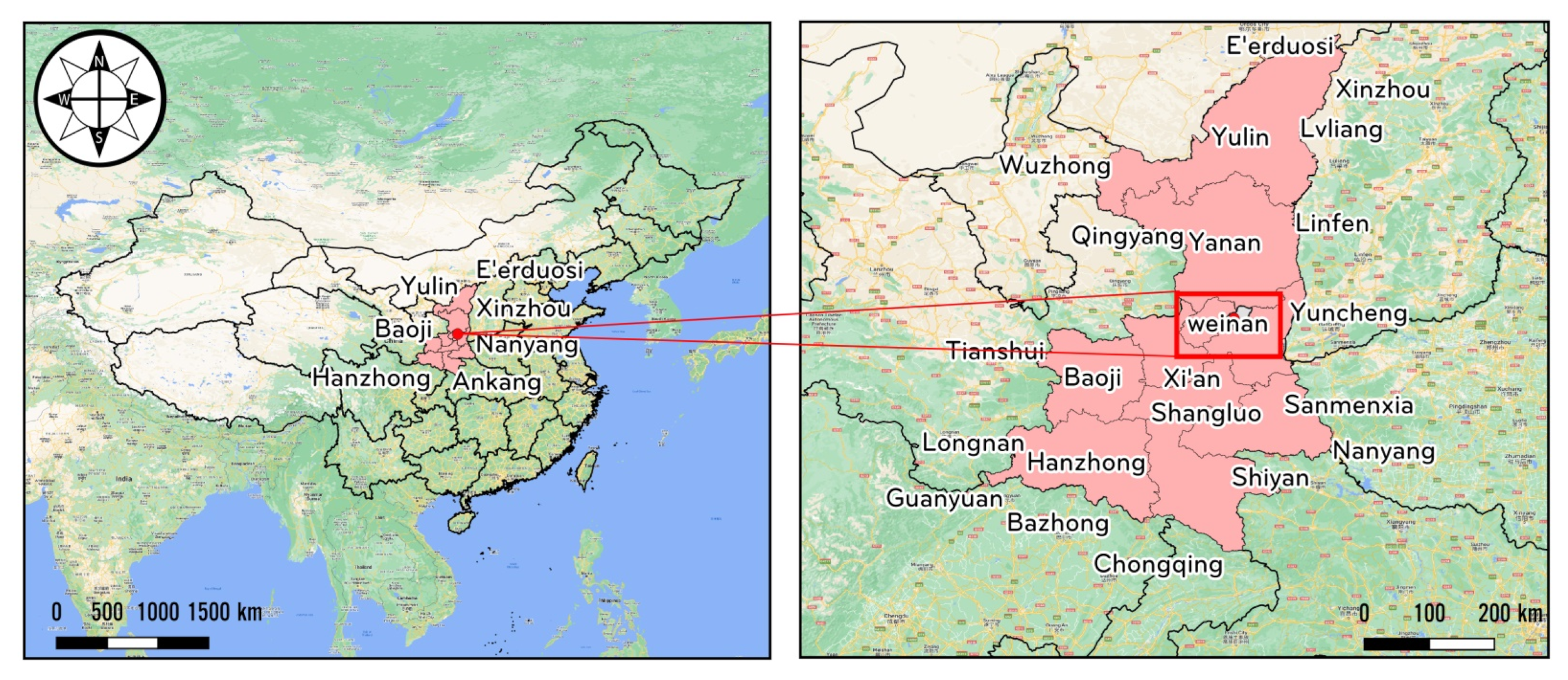
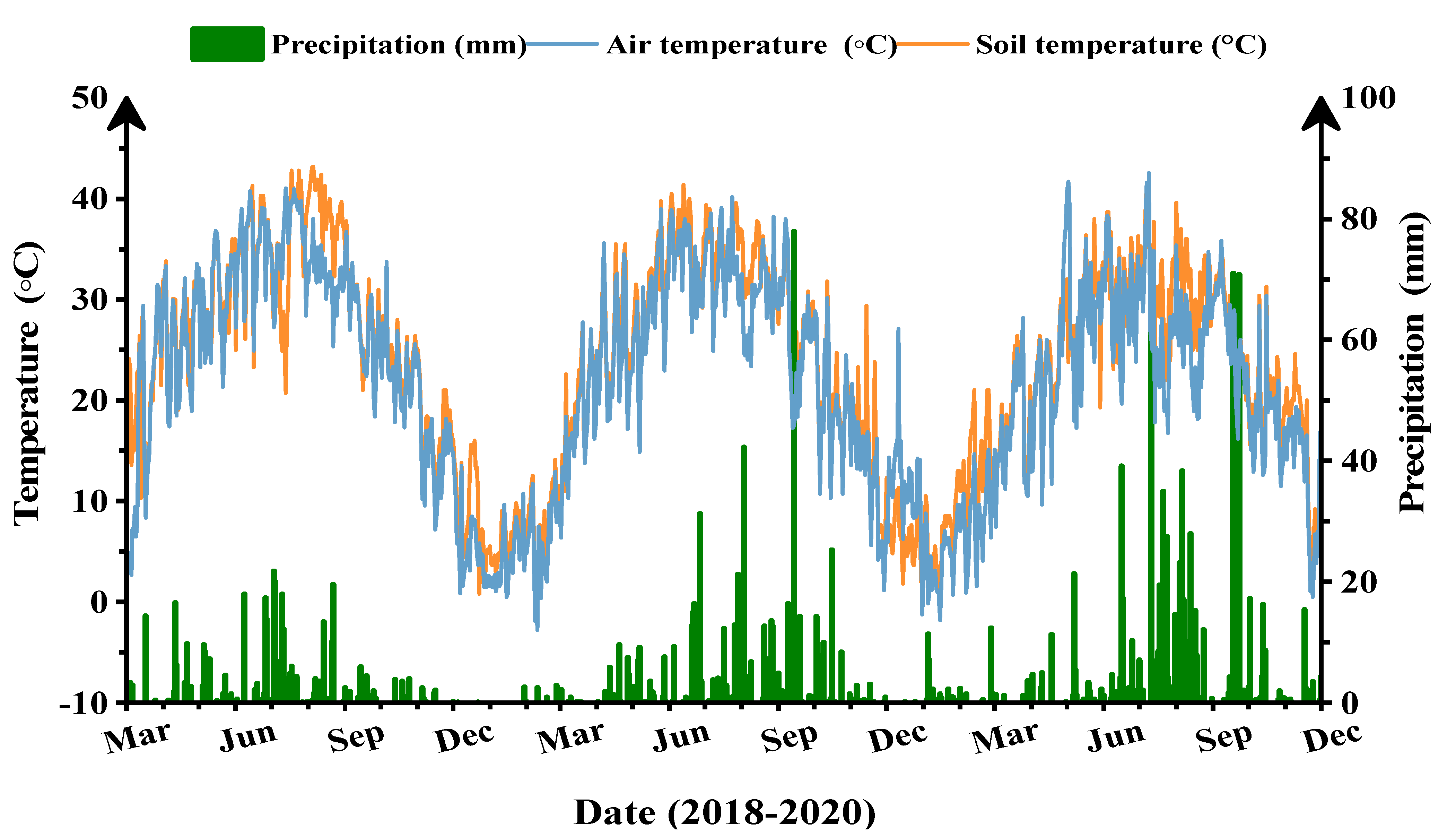
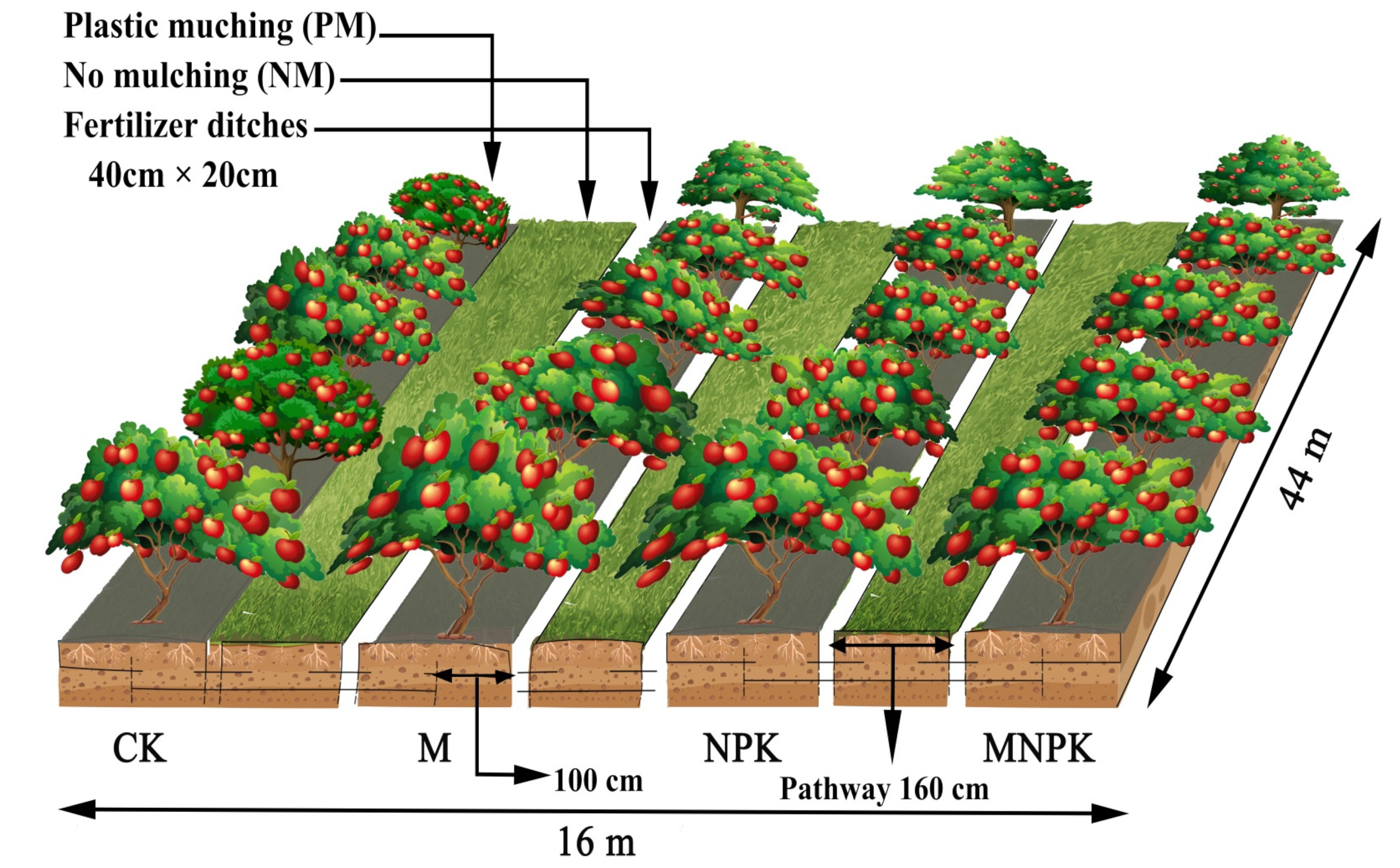
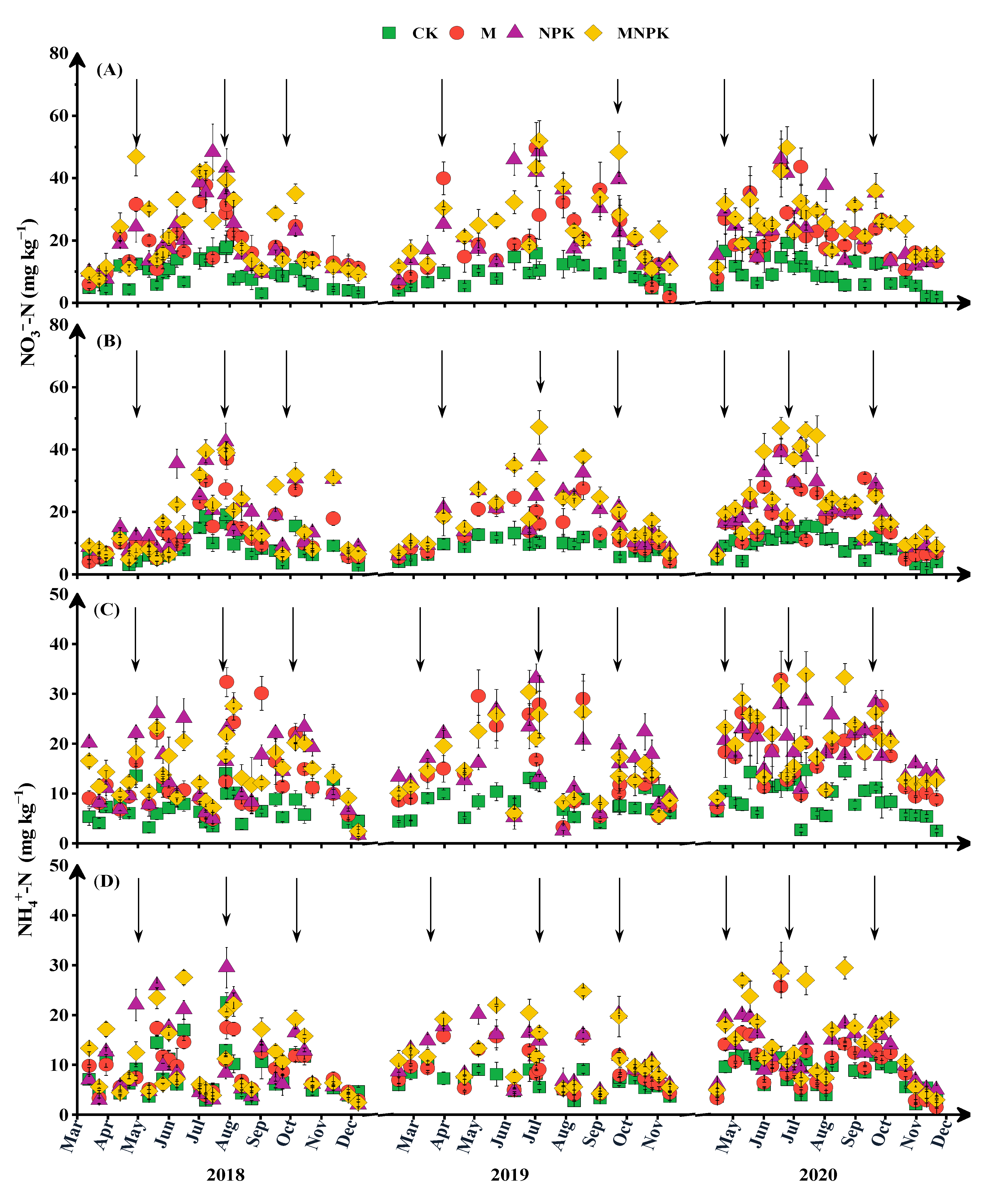
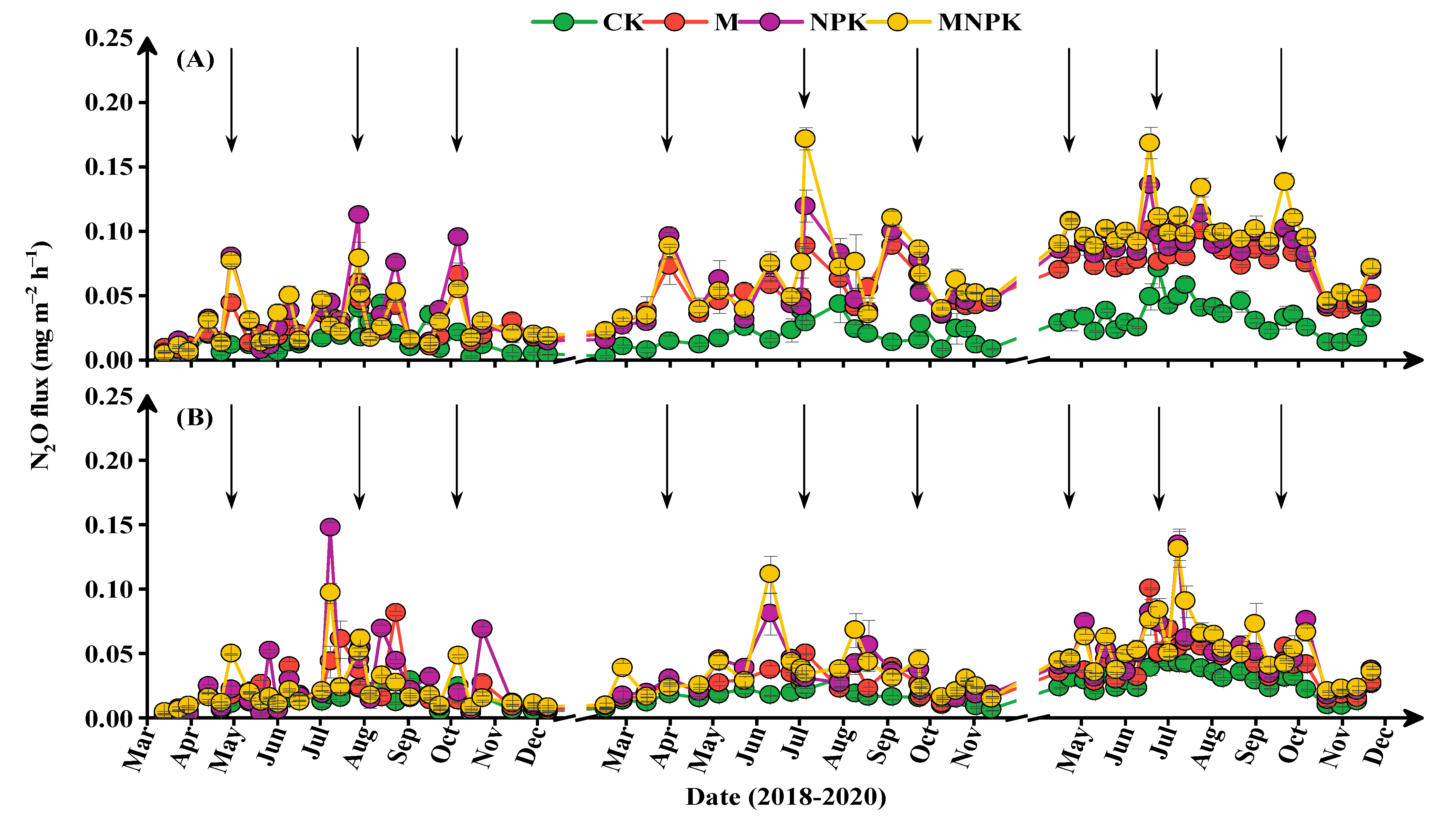
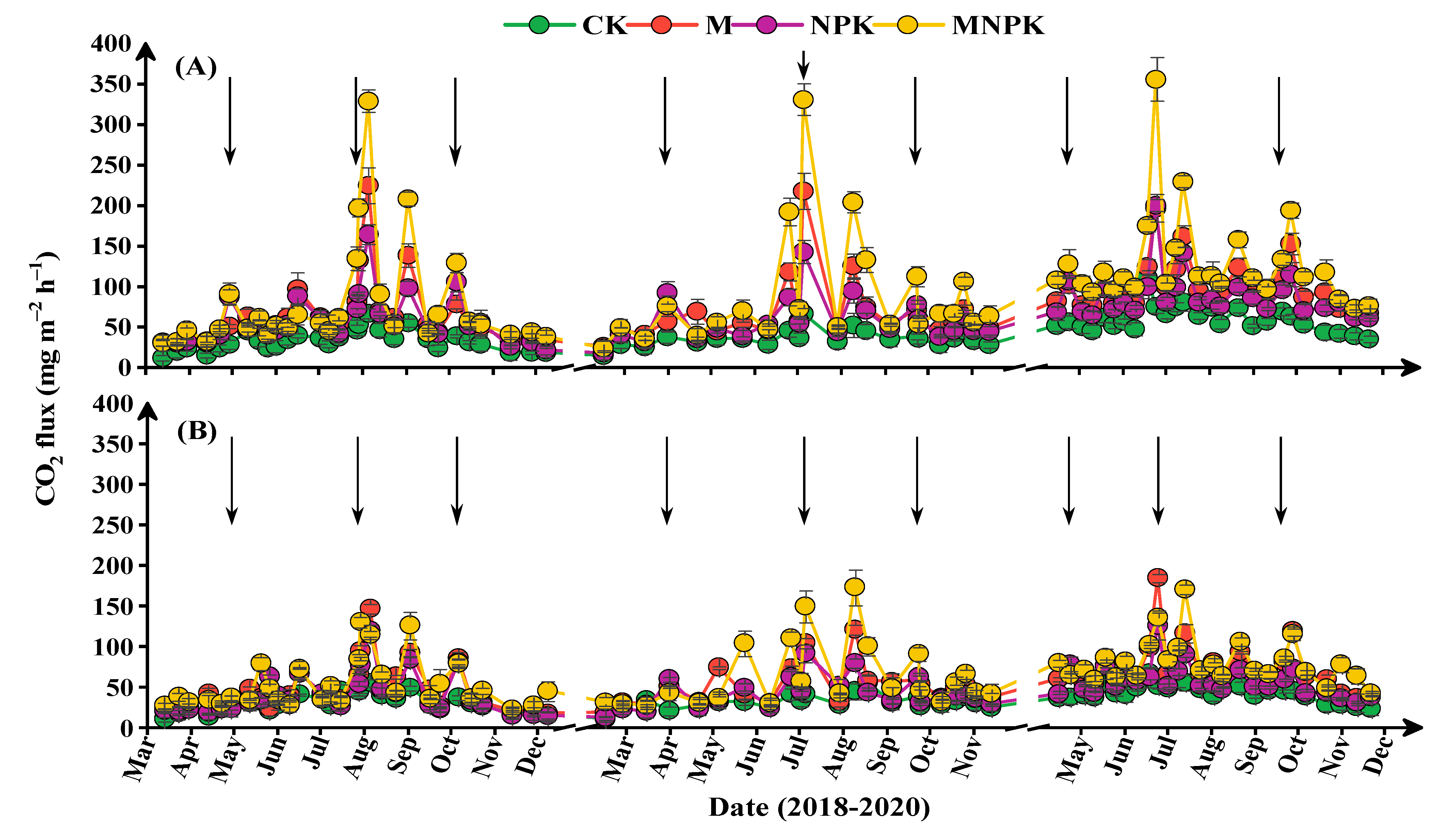

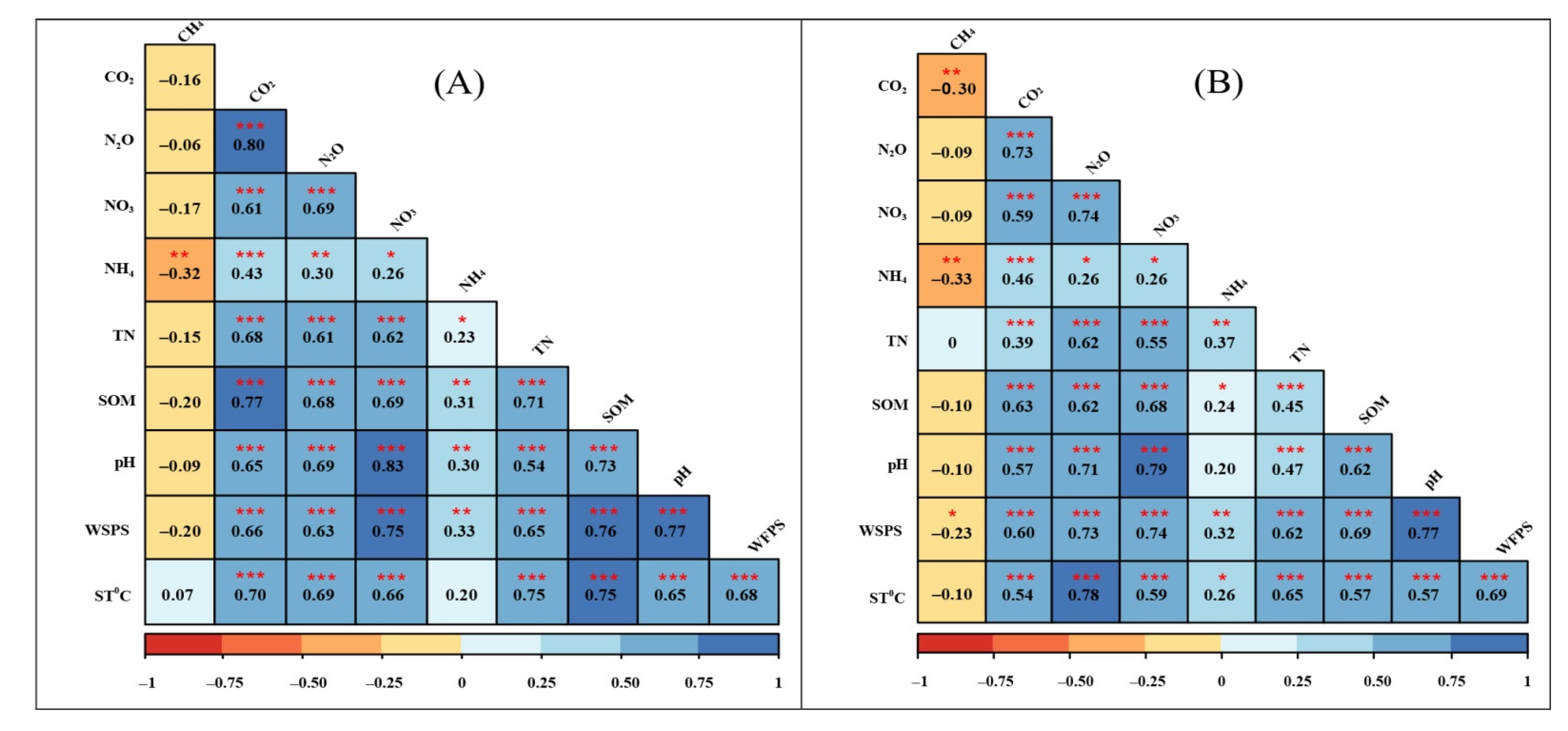
| Treatment 1 | Inorganic Fertilizer 2 | Organic Fertilizer 3 | The Total Amount of N Fertilizer Applied 4 | ||
|---|---|---|---|---|---|
| N | P2O5 | K2O | |||
| CK | 0 | 0 | 0 | 0 | 0 |
| M | 0 | 0 | 0 | 45,000 | 68 |
| NPK | 675 | 405 | 405 | 0 | 675 |
| MNPK | 640 | 405 | 405 | 22,500 | 675 |
| Year | T 1 | Apple Yield (t ha−1) 2 | CH4 Emission (kg ha−1) 3 | CO2 Emission (t ha−1) 4 | N2O Emission (kg ha−1) 5 | |||
|---|---|---|---|---|---|---|---|---|
| PM | NM | PM | NM | PM | NM | |||
| 2018 | CK | 28.54 ± 4.05 c | −1.32 ± 0.02 a | −1.51 ± 0.03 a | 2.10 ± 0.12 d | 1.98 ± 0.13 d | 0.87 ± 0.03 d | 0.75 ± 0.06 d |
| M | 40.04 ± 4.08 b | −4.06 ± 0.09 d | −5.45 ± 0.19 d | 4.07 ± 0.04 b | 2.94 ± 0.15 b | 1.63 ± 0.50 c | 1.34 ± 0.03 c | |
| NPK | 23.97 ± 2.51 c | −2.16 ± 0.12 b | −2.97 ± 0.05 b | 3.68 ± 0.02 c | 2.54 ± 0.06 c | 2.13 ± 0.11 a | 1.71 ± 0.05 a | |
| MNPK | 51.72 ± 5.00 a | −3.20 ± 0.17 c | −4.23 ± 0.21 c | 4.83 ± 0.08 a | 3.28 ± 0.16 a | 1.89 ± 0.15 b | 1.43 ± 0.03 b | |
| 2019 | CK | 28.53 ± 5.92 d | −1.34 ± 0.25 a | −1.51 ± 0.19 a | 2.36 ± 0.26 d | 2.08 ± 0.22 d | 1.15 ± 0.02 d | 1.05 ± 0.04 d |
| M | 65.18 ± 8.50 b | −4.25 ± 0.05 d | −6.75 ± 0.37 d | 4.35 ± 0.15 b | 3.32 ± 0.07 b | 3.47 ± 0.11 c | 1.75 ± 0.02 c | |
| NPK | 50.35 ± 10.60 c | −2.58 ± 0.24 b | −3.90 ± 0.20 b | 3.77 ± 0.11 c | 2.78 ± 0.22 c | 3.81 ± 0.12 b | 2.18 ± 0.03 b | |
| MNPK | 93.43 ± 11.96 a | −3.85 ± 0.18 c | −5.36 ± 0.34 c | 5.65 ± 0.18 a | 4.06 ± 0.29 a | 4.22 ± 0.24 a | 2.38 ± 0.14 a | |
| 2020 | CK | 30.98 ± 5.73 c | −1.19 ± 0.05 a | −1.14 ± 0.05 a | 3.13 ± 0.18 d | 2.29 ± 0.14 d | 1.52 ± 0.02 d | 1.28 ± 0.24 d |
| M | 61.11 ± 12.96 a | −2.27 ± 0.06 c | −4.94 ± 0.14 d | 5.34 ± 0.26 b | 3.86 ± 0.13 b | 4.02 ± 0.03 c | 2.23 ± 0.02 c | |
| NPK | 45.44 ± 5.86 b | −1.67 ± 0.09 b | −2.94 ± 0.16 b | 4.60 ± 0.28 c | 2.98 ± 0.13 c | 4.60 ± 0.12 b | 2.67 ± 0.06 b | |
| MNPK | 58.60 ± 9.48 a | −2.52 ± 0.06 d | −4.07 ± 0.19 c | 6.68 ± 0.19 a | 4.27 ± 0.10 a | 5.07 ± 0.03 a | 2.90 ± 0.06 a | |
| AV | CK | 29.35 ± 2.05 d | −1.28 ± 0.06 a | −1.38 ± 0.05 a | 2.53 ± 0.19 c | 2.12 ± 0.16 d | 1.18 ± 0.07 d | 1.03 ± 0.01 d |
| M | 55.45 ± 2.14 b | −3.53 ± 0.02 d | −5.71 ± 0.15 d | 4.59 ± 0.14 b | 3.37 ± 0.10 b | 3.04 ± 0.06 c | 1.77 ± 0.01 c | |
| NPK | 39.92 ± 1.75 c | −2.14 ± 0.02 b | −3.27 ± 0.14 b | 4.02 ± 0.06 b | 2.77 ± 0.12 c | 3.51 ± 0.04 b | 2.19 ± 0.02 b | |
| MNPK | 67.91 ± 2.90 a | −3.19 ± 0.14 c | −4.55 ± 0.14 c | 5.72 ± 0.15 a | 3.87 ± 0.18 a | 3.73 ± 0.12 a | 2.24 ± 0.04 a | |
| Year | T 1 | GWP (Emission CO2-eq ha−1) 2 | GHGI (g kg−1) 3 | N2O Emission EFd (%) 4 | |||
|---|---|---|---|---|---|---|---|
| PM | NM | PM | NM | PM | NM | ||
| 2018 | CK | 227.68 ± 17.69 d | 184.64 ± 19.12 d | 8.06 ± 0.88 c | 6.50 ± 1.40 b | - | - |
| M | 385.46 ± 13.31 c | 264.08 ± 18.26 c | 9.68 ± 0.77 b | 6.65 ± 2.77 b | - | - | |
| NPK | 580.60 ± 7.30 a | 435.91 ± 13.52 a | 24.40 ± 2.58 a | 18.30 ± 1.78 a | 0.19 ± 0.10 a | 0.14 ± 0.05 b | |
| MNPK | 483.44 ± 39.92 b | 319.70 ± 14.83 b | 9.36 ± 0.32 b | 6.22 ± 1.53 b | 0.16 ± 0.21 a | 0.11 ± 0.02 a | |
| 2019 | CK | 309.57 ± 17.28 d | 276.68 ± 11.50 c | 10.86 ± 0.50 d | 9.70 ± 2.10 a | - | - |
| M | 927.65 ± 36.31 c | 352.76 ± 16.26 b | 14.25 ± 0.76 b | 5.42 ± 0.29 b | - | - | |
| NPK | 1069.93 ± 31.49 b | 553.05 ± 13.47 a | 21.25 ± 0.43 a | 10.99 ± 0.37 a | 0.39 ± 0.20 b | 0.17 ± 0.03 b | |
| MNPK | 1162.15 ± 28.19 a | 576.07 ± 40.10 a | 12.44 ± 0.61 c | 6.17 ± 0.54 b | 0.48 ± 0.42 a | 0.21 ± 0.02 a | |
| 2020 | CK | 422.75 ± 17.59 d | 352.35 ± 10.50 d | 13.68 ± 1.89 d | 11.40 ± 1.65 b | - | - |
| M | 1141.13 ± 11.79 c | 539.75 ± 26.60 c | 18.68 ± 3.38 c | 8.83 ± 2.23 c | - | - | |
| NPK | 1330.07 ± 15.46 b | 722.77 ± 19.75 b | 29.31 ± 1.21 a | 15.94 ± 2.09 a | 0.46 ± 0.20 b | 0.21 ± 0.01 b | |
| MNPK | 1446.27 ± 10.54 a | 763.78 ± 23.80 a | 24.74 ± 1.48 b | 13.06 ± 2.75 b | 0.55 ± 0.60 a | 0.25 ± 0.06 a | |
| AV | CK | 320.00 ± 7.40 d | 271.22 ± 17.26 d | 10.87 ± 0.62 d | 9.20 ± 2.34 b | - | - |
| M | 818.08 ± 19.13 c | 385.53 ± 22.19 c | 14.20 ± 0.49 c | 6.97 ± 2.34 d | - | - | |
| NPK | 993.54 ± 10.55 b | 570.58 ± 22.61 a | 24.99 ± 1.13 a | 15.08 ± 2.86 a | 0.35 ± 0.05 b | 0.17 ± 0.01 b | |
| MNPK | 1030.62 ± 33.15 a | 553.18 ± 19.84 b | 15.51 ± 0.37 b | 8.48 ± 4.60 c | 0.40 ± 0.02 a | 0.19 ± 0.01 a | |
Disclaimer/Publisher’s Note: The statements, opinions and data contained in all publications are solely those of the individual author(s) and contributor(s) and not of MDPI and/or the editor(s). MDPI and/or the editor(s) disclaim responsibility for any injury to people or property resulting from any ideas, methods, instructions or products referred to in the content. |
© 2023 by the authors. Licensee MDPI, Basel, Switzerland. This article is an open access article distributed under the terms and conditions of the Creative Commons Attribution (CC BY) license (https://creativecommons.org/licenses/by/4.0/).
Share and Cite
Sompouviset, T.; Ma, Y.; Sukkaew, E.; Zheng, Z.; Zhang, A.; Zheng, W.; Li, Z.; Zhai, B. The Effects of Plastic Mulching Combined with Different Fertilizer Applications on Greenhouse Gas Emissions and Intensity, and Apple Yield in Northwestern China. Agriculture 2023, 13, 1211. https://doi.org/10.3390/agriculture13061211
Sompouviset T, Ma Y, Sukkaew E, Zheng Z, Zhang A, Zheng W, Li Z, Zhai B. The Effects of Plastic Mulching Combined with Different Fertilizer Applications on Greenhouse Gas Emissions and Intensity, and Apple Yield in Northwestern China. Agriculture. 2023; 13(6):1211. https://doi.org/10.3390/agriculture13061211
Chicago/Turabian StyleSompouviset, Thongsouk, Yanting Ma, Eakkarin Sukkaew, Zhaoxia Zheng, Ai Zhang, Wei Zheng, Ziyan Li, and Bingnian Zhai. 2023. "The Effects of Plastic Mulching Combined with Different Fertilizer Applications on Greenhouse Gas Emissions and Intensity, and Apple Yield in Northwestern China" Agriculture 13, no. 6: 1211. https://doi.org/10.3390/agriculture13061211
APA StyleSompouviset, T., Ma, Y., Sukkaew, E., Zheng, Z., Zhang, A., Zheng, W., Li, Z., & Zhai, B. (2023). The Effects of Plastic Mulching Combined with Different Fertilizer Applications on Greenhouse Gas Emissions and Intensity, and Apple Yield in Northwestern China. Agriculture, 13(6), 1211. https://doi.org/10.3390/agriculture13061211









